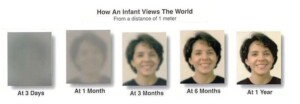The first year of a baby’s life is a period of rapid and astonishing development, with vision being one of the most remarkable areas of growth. At birth, a baby’s vision is limited, but it undergoes significant changes in the first 12 months. This journey from blurry sight to clear vision is not only fascinating but also highlights the incredible developmental processes during early childhood.

Vision at Birth
Initial Limitations
- Newborns have limited vision. They can see objects only about 8 to 12 inches away – just the right distance to see the face of the person holding them.
- Their vision is generally 20/400, meaning what they can see at 20 feet, a person with normal vision can see at 400 feet.
Color Perception
- Babies are born with a rudimentary ability to perceive color, but they initially see high-contrast colors more clearly, particularly black and white.
Development in the First Few Months
Focus and Tracking
- By around 3 months, babies start to focus on and track moving objects. They begin to reach out and grasp things, indicating better hand-eye coordination.
Color Vision
- Around 4 months, babies’ color vision develops, and they start distinguishing between different colors, with a preference for bright primary hues.
Rapid Growth and Refinement
Depth Perception
- Between 5 and 8 months, babies develop depth perception. This is when they start to understand how far away an object is, which is crucial for crawling and exploring.
Clarity and Distance
- By 6 months, a baby’s vision is much clearer, reaching 20/20 or close to it. They can recognize familiar faces even at a distance.
One Year Milestone
Visual Acuity
- By their first birthday, most babies have fairly good vision, close to that of an adult’s in terms of clarity and depth perception.
Recognizing and Interacting
- One-year-olds can recognize people and objects at different distances, interact more effectively with their environment, and are better at judging distances.
The Importance of Vision Checks
Regular Check-ups
- Regular pediatric check-ups are important to ensure that a baby’s eyes are developing normally and to catch any issues early.
Stimulating Vision Development
- Providing colorful toys, playing interactive games, and ensuring plenty of time for exploring can help stimulate a baby’s visual development.
The first year of a baby’s life is a critical period for vision development. From seeing only a few inches away at birth to developing near-adult levels of vision by their first birthday, the progress is nothing short of miraculous. This journey not only underscores the complexity of human development but also the importance of nurturing and monitoring this growth. It’s a reminder of how much time and care it takes for our bodies, particularly our vision, to develop during these early, formative years.
Q: How can I tell if my baby’s vision is developing normally? A: Normal vision development includes reaching milestones like following objects with their eyes by 3 months and recognizing familiar faces from a distance by 6 months. However, every baby is different. Regular pediatric check-ups are crucial to monitor their vision development.
Q: When should I take my baby for their first eye check-up? A: It’s recommended to have a baby’s first comprehensive eye examination at about 6 months of age. This check-up can identify any early issues that might affect normal vision development.
Q: Can babies see color when they’re born? A: Newborns can see colors, but their color vision is not as sensitive as an adult’s. They initially see high-contrast colors more clearly and develop full color vision around 4 months.
Q: Why do babies need to develop depth perception? A: Depth perception is crucial for babies to understand their environment. It helps them in reaching out and grasping objects, crawling, and eventually walking. It typically develops between 5 and 8 months.
Q: How can I help my baby’s vision development? A: You can stimulate your baby’s vision by providing toys with contrasting colors, playing interactive games, and giving them a chance to explore different environments. Face-to-face interaction is also beneficial.
Q: Is it normal for a baby’s eyes to occasionally appear misaligned? A: It’s common for babies’ eyes to appear slightly crossed or misaligned occasionally, especially in the first few months. However, if you notice this regularly or persistently, consult a pediatrician or an eye specialist.
Q: Can watching TV or looking at screens affect a baby’s vision development? A: Excessive screen time is not recommended for babies. It’s better to engage them with real-world interactions and physical toys that encourage natural visual development.
Q: Do genetics play a role in vision development? A: Genetics can play a role in certain aspects of vision and eye health. If there’s a family history of eye conditions, it’s important to monitor a baby’s vision development closely.
Q: How quickly does a baby’s vision reach 20/20? A: Most babies achieve 20/20 vision or close to it by around 6 months. However, individual development can vary.
Q: Should I be concerned if my baby isn’t reaching vision milestones? A: If you’re concerned about your baby’s vision development, it’s always best to consult with a pediatrician or an eye specialist. Early detection of any issues can make a significant difference in treatment and outcomes.
As an Amazon Associate we earn from qualifying purchases through some links in our articles.



